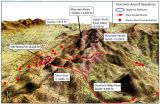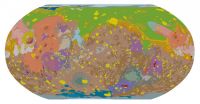(Press-News.org) CORVALLIS, Ore. – A recent Oregon survey about an exercise DVD that adds short breaks of physical activity into the daily routine of elementary school students found it had a high level of popularity with both students and teachers, and offered clear advantages for overly sedentary educational programs.
Called "Brain Breaks," the DVD was developed and produced by the Healthy Youth Program of the Linus Pauling Institute at Oregon State University, and is available nationally.
Brain Breaks leads children in 5-7 minute segments of physical activity, demonstrated by OSU students and elementary school children from Corvallis, Oregon. The short periods of exercise aim to improve the physical health, mental awareness and educational success of children.
"We're increasingly recognizing the importance of physical activity for children even as the academic demands placed on them are cutting into the traditional programs of recess and physical education," said Gerd Bobe, an assistant professor in the OSU College of Agricultural Sciences, an expert in public health nutrition and behavior, and principal investigator with the Linus Pauling Institute.
"Kids need to move, they can't just sit all day long," Bobe said. "Given the time constraints and multiple demands that schools are facing, we really believe the concept of short activity breaks, right in the classroom, is the way to go."
Oregon law, for instance, mandates that by 2017 elementary schools will be required to have 30 minutes a day of physical education classes, in addition to recess periods. But a survey conducted by the Healthy Youth Program found that 92 percent of Oregon public elementary schools currently do not meet this standard. And sometimes, Bobe said, elimination of recess is used as a disciplinary tool, potentially taking activity away from those students who may need it the most.
Brain Breaks was created to bring more activity back into classrooms, especially when it may be most useful – in the afternoon after lunch, for instance, when attention spans and concentration tend to waver. Research has shown that physical activity can increase academic performance, student focus and classroom behavior, Bobe said.
The program offers a variety of segments, including six based on stretching and relaxation, five on endurance, and one on strength, with imaginative concepts such as "space adventures" and "crazy kangaroos." No equipment is needed, other than a chair for the strength segment, and all activities can be done in a classroom setting. An abstract of the work has been published in the Journal of Nutrition Education and Behavior.
A recent survey of the Healthy Youth Program that was sent to participating Oregon school districts found that:
Almost all teachers said the program was appropriate for their classes and well-understood by the class;
More than 90 percent of teachers said the exercise segments had the right length, and that students were more focused after using the program;
All of the segments were popular with more than 80 percent of students, but the stretching and relaxation activities had the highest approval, at 95 percent, and were also most frequently used by teachers;
About three-fourths of the teachers were using the program two to three times per week, and more than 90 percent plan to continue its use.
"Longer periods of exercise have a place, but research shows that these short programs can be very valuable as well," Bobe said. "They can increase oxygen consumption, range of motion, endurance, and get kids in the habit of being more active. A little bit of exercise can go a long way."
A second edition of the DVD is being developed, Bobe said. More information on the DVD is available online at http://bit.ly/1o6rcHk, including a video trailer and how to buy a copy.
"This survey shows a program that's working and is valuable," Bobe said. "We hope it becomes popular across the nation."
INFORMATION:
'Brain Breaks' increase activity, educational performance in elementary schools
2014-09-23
ELSE PRESS RELEASES FROM THIS DATE:
Surveys may assess language more than attitudes, says study involving CU-Boulder
2014-09-23
Scientists who study patterns in survey results might be dealing with data on language rather than what they're really after -- attitudes -- according to an international study involving the University of Colorado Boulder.
The study, published in the journal PLOS ONE, found that people naturally responded to surveys by selecting answer options that were similar in language to each other as they navigated from one question to another, even when the similarities were subtle.
For the study, researchers looked specifically at surveys on organizational behavior, such as ...
Researchers reveal new rock formation in Colorado
2014-09-23
Boulder, Colo., USA - An astonishing new rock formation has been revealed in the Colorado Rockies, and it exists in a deeply perplexing relationship with older rocks. Named the Tava sandstone, this sedimentary rock forms intrusions within the ancient granites and gneisses that form the backbone of the Front Range. The relationship is fascinating because it is backward: ordinarily, it is igneous rocks such as granite that would that intrude into sedimentary rocks.
According to authors Christine Smith Siddoway and George E. Gehrels, to find sandstone injected into granite ...
Note to young men: Fat doesn't pay
2014-09-23
Men who are already obese as teenagers could grow up to earn up to 18 percent less than their peers of normal weight. So says Petter Lundborg of Lund University, Paul Nystedt of Jönköping University and Dan-olof Rooth of Linneas University and Lund University, all in Sweden. The team compared extensive information from Sweden, the United Kingdom and the United States, and the results are published in Springer's journal Demography.
The researchers analyzed large-scale data of 145,193 Swedish-born brothers who enlisted in the Swedish National Service for mandatory military ...
Immune system is key ally in cyberwar against cancer
2014-09-23
Research by Rice University scientists who are fighting a cyberwar against cancer finds that the immune system may be a clinician's most powerful ally.
"Recent research has found that cancer is already adept at using cyberwarfare against the immune system, and we studied the interplay between cancer and the immune system to see how we might turn the tables on cancer," said Rice University's Eshel Ben-Jacob, co-author of a new study this week in the Early Edition of the Proceedings of the National Academy of Sciences.
Ben-Jacob and colleagues at Rice's Center for Theoretical ...
UTSA microbiologists discover regulatory thermometer that controls cholera
2014-09-23
Karl Klose, professor of biology and a researcher in UTSA's South Texas Center for Emerging Infectious Diseases, has teamed up with researchers at Ruhr University in Bochum, Germany to understand how humans get infected with cholera, Their findings were released this week in an article published by the Proceedings of the National Academy of Sciences.
Cholera is an acute infection caused by ingestion of food or water that is contaminated with the bacterium Vibrio cholerae. An estimated three to five million cases are reported annually and 100,000-120,000 people die from ...
'Space bubbles' may have aided enemy in fatal Afghan battle
2014-09-23
WASHINGTON, DC—In the early morning hours of March 4, 2002, military officers in Bagram, Afghanistan desperately radioed a Chinook helicopter headed for the snowcapped peak of Takur Ghar. On board were 21 men, deployed to rescue a team of Navy SEALS pinned down on the ridge dividing the Upper and Lower Shahikot valley. The message was urgent: Do not land on the peak. The mountaintop was under enemy control.
The rescue team never got the message. Just after daybreak, the Chinook crash-landed on the peak under heavy enemy fire and three men were killed in the ensuing firefight.
A ...
This week from AGU: New geologic map of Mars, storm surge in Florida
2014-09-23
From this week's Eos: The New Geologic Map of Mars: Guiding Research and Education
Currently, five spacecraft are investigating Mars, and a swarm of new missions to the Red Planet either have been launched or are in development. They are designed to probe the surface, subsurface, and atmosphere with a host of scientific instruments. Where will they make new discoveries? Clues to where they should focus investigations can be gleaned from the planet's new geologic map.
From AGU's journals: History of storm surge in Florida strongly underestimated
The observational ...
Water-quality trading can reduce river pollution
2014-09-23
DURHAM, N.C. -- Allowing polluters to buy, sell or trade water-quality credits could significantly reduce pollution in river basins and estuaries faster and at lower cost than requiring the facilities to meet compliance costs on their own, a new Duke University-led study finds.
The scale and type of the trading programs, though critical, may matter less than just getting them started.
"Our analysis shows that water-quality trading of any kind can significantly lower the costs of achieving Clean Water Act goals," said Martin W. Doyle, professor of river science and policy ...
State policies are effective in reducing power plant emissions, CU-led study finds
2014-09-23
A new study led by the University of Colorado Boulder found that different strategies used by states to reduce power plant emissions -- direct ones such as emission caps and indirect ones like encouraging renewable energy -- are both effective. The study is the first analysis of its kind.
The findings are important because the success of the Environmental Protection Agency's proposed Clean Power Plan depends on the effectiveness of states' policies in reducing power plants' carbon dioxide emissions. The plan would require each state to cut CO2 pollution from power plants ...
Big changes in the Sargasso Sea
2014-09-23
Over one thousand miles wide and three thousand miles long, the Sargasso Sea occupies almost two thirds of the North Atlantic Ocean. Within the sea, circling ocean currents accumulate mats of Sargassum seaweed that shelter a surprising variety of fishes, snails, crabs, and other small animals. A recent paper by MBARI researcher Crissy Huffard and others shows that in 2011 and 2012 this animal community was much less diverse than it was in the early 1970s, when the last detailed studies were completed in this region.
This study was based on field research led by MBARI ...




